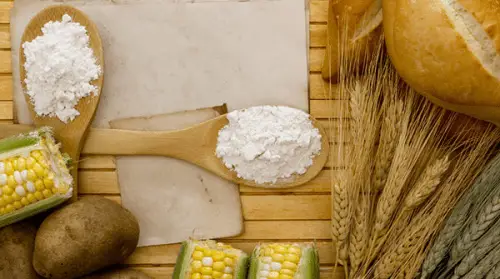Although they are both made up of the same substance, starch and cellulose are completely different types of polymers. This article provides a comprehensive comparison of the two.
Summary Table
| Starch | Cellulose |
| Made up of two types of alpha-glucose | Made up of 1 type of beta-glucose |
| Can either form straight chains or branch out to create helical structures and multiple coils | Can only form straight chains |
| Connected by alpha linkages | Connected by beta linkages |
| Exists as amylose and amylopectin | Exists as ignin, hemicellulose. and pure cellulose |
| Morphs between 60 to 70 °C | Morphs at 320 °C |
| Highly digestible | Difficult to digest |
| Ideal for human consumption | Not ideal for human consumption |
| Used by plants for energy storage | Used by plants for structural support |
| Abundant in food items such as corn, potatoes, rice, wheat, cassava, whisky, beer, and biofuel | Abundant in paper, paperboard, cotton, and wood pulp |
Definitions

Starch, also known as amylum, is a polymeric carbohydrate generated by green plants for energy storage. An odorless and tasteless powder made up of numerous glucose units, starch is one of the most common carbohydrates in the human diet.

Meanwhile, cellulose is an organic polymer that forms the cell wall of green plants, oomycetes, and algae. It is made up of linear chains of glucose units and it plays an important role in the production of commercial and industrial products.
Starch vs Cellulose
Despite their notable similarities, there is a major difference between starch and cellulose, specifically in terms of structural composition, digestibility, application, and use.
Structure
Starch is a polymeric carbohydrate made up of two types of alpha-glucose, which is a type of glucose with an -OH group attached below the ring. The position of the -OH group enables the glucose rings to either form straight chains or branch out to create helical structures and multiple coils.
Cellulose, on the other hand, is made up of 1 type of beta-glucose units linked together by glycosidic bonds. Unlike starch, the -OH group in cellulose is linked above the ring, consequently restricting the polymer to create a branched chain. Since it can only form straight chains, it cannot coil or branch out.
Linkage
The molecular structure of glucose greatly affects linkage. While the alpha-glucose molecules in starch are connected by alpha linkages, the beta-glucose molecules in cellulose are linked by beta linkages.
Forms
Starch exists in two forms: the linear amylose and the branched amylopectin. Cellulose, by comparison, is available as lignin, hemicellulose, and pure cellulose.
Metamorphosis
Between the two, cellulose is more crystallized and more resistant to distortion. Unlike starch that morphs between 60 to 70 °C, the integrity of cellulose can only change at a temperature as high as 320 °C.
Digestibility
Starch is a highly digestible, tasteless compound popularly used in the human diet. Cellulose, by contrast, cannot be incorporated into the human diet since it is not digestible.
Only specific animals such as ruminants and termites are capable of digesting cellulose due to the unique microorganisms present in their gut.
Function
Starch is a polymer generated by plants for energy storage, while cellulose mainly aids in providing structural support for plants by the use of microtubules.
Applications
Starch is one of the most common types of carbohydrates ideal for human consumption. It is abundant in food items such as corn, potatoes, rice, wheat, and cassava. When used for industrial purposes, starch is used for the production of whisky, beer, and biofuel.
Meanwhile, cellulose is widely used in manufacturing paper and paperboard. In other industries, it is also used in making cotton and wood pulp.





